#07: Design iteration: player movement
This post was originally written in February 2019. At the time the game was still called Hook, Line and Thinker
In this game all you do is move and reel back in. Sound simple? Making games is hard.
A couple of caveats for the days per version listed here. It’s a rough estimate based on days where there’s a relevant commit in the log, but some commits represent several days of work, often there are many tweaks done later which are bundled under other commits, I may have been working on other stuff too, and some of these were weekend / full days while others were just evenings after work. Still interesting though.
Version 1: Moving and reeling in (4 days, October 2016)
According to the daily devlog I wrote during the week-long game jam, I had movement working on day 1; collision on day 2; reeling in the hook on day 3; and reeling in creatures on day 5. When you pushed the reel-in button you were committed to reeling all the way in, with no way to stop it or undo your action. This was particularly annoying on puzzles which require you to drop creatures since you had to wait for the hook to reel all the way back in before moving it again.
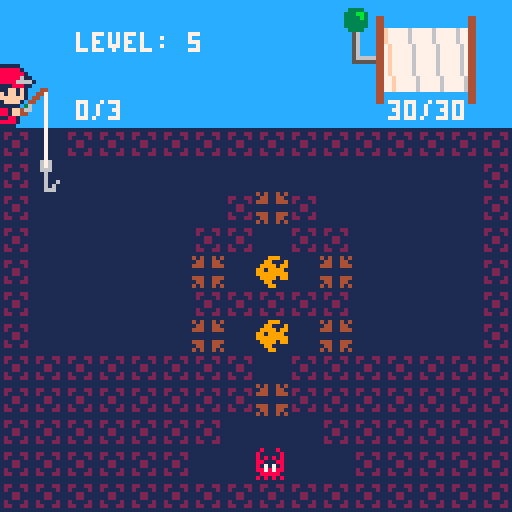
My thinking at the time was that by making every move matter it would encourage force players to think through their actions before taking them, rather than using trial-and-error to fudge their way to a solution. I think there’s several issues with that reasoning. For one thing, I don’t explicitly tell the player anything about how to play, instead using level design to prompt players to work things out for themselves (devlog 3) through experimentation. Making every move matter is directly opposed to this, causing players’ introduction to the game to be needlessly punishing.
In my opinion, as designer it is not my job to prescribe how players play my game. It is my job to prescribe what they’re trying to do and what tools they have to accomplish their goals (which they may have even set themselves). If someone wants or needs to trial-and-error their way through a puzzle that is a perfectly valid way of playing the game. Do I think that’s the most enjoyable way to play? No. Does the design facilitate such a playstyle anyway? Yes. Encourage it? Early on, yes. People learn through mistakes and using trial-and-error is a great way to make a lot of mistakes fast. Through this experimentation players will (hopefully) start to understand the mechanics of the game and gain the ability to reason about and predict the effects of their actions before making them (consistency is key here). At this point the player transitions from trying to complete the level to trying to solve the puzzle.
Version 2: Limited undo (1 day, May 2017)
After initially being opposed to any undo at all, my design thinking changed over time and eventually landed on unlimited unrestricted undo (devlog 6). This was the first step towards that: you could undo your movements up to grabbing a creature, but once you reeled it in there was no way to cancel it or undo the effects other than to restart the level.
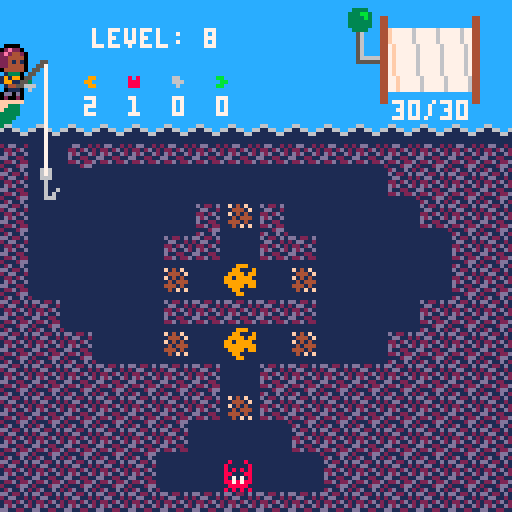
This was better than no undo at all but the restrictions immediately felt frustrating and arbitrary. As a player I felt a little more free and relaxed about my movements, because a misjudged or accidental button press was no longer a loss of progress (prior to this an error meant at best reeling in the whole line to play it out again, at worst having to restart the entire level). Around this time I added full undo to my todo list.
Version 3: Interrupting an empty reel-in (1 day, October 2017)
This was another way for the player to recover from a misclick. I showed the game to a couple of friends and noticed that they sometimes reeled the hook in after getting adjacent to a creature but not actually grabbing it. They would immediately realise their mistake and jab at the movement buttons in a panic, trying to recover their lost progress as the hook wound its way back to the start. Cue frustration and helplessness.
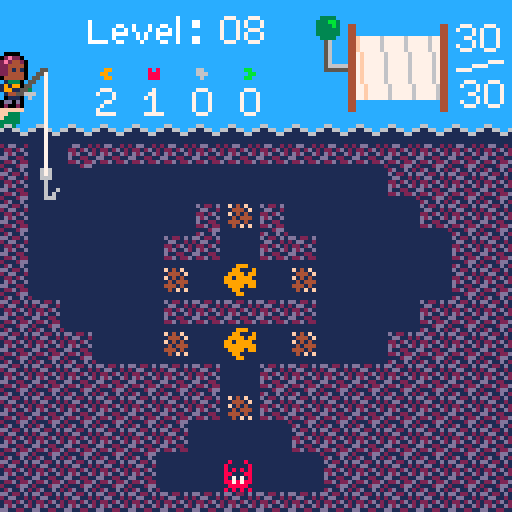
Once I added this I used it constantly as a way to explore levels; approaching something from one side, then reeling in partially and approaching it from another. It increased my options as a player and made stress testing levels for broken solutions easier. My only concern was that it potentially made patrol fish trivial. Patrols move when you move and the intent was that you’d have to outsmart them by creating a trap with your line. They were the most frustrating part of the game because you often knew how and where you wanted to trap them, but when you got there you were out of sync with their movements and couldn’t execute your plan through no real fault of your own, instead having to resort to reeling in and trying again until everything happened to line up. Being able to resume movement after reeling in meant you could now sort of wiggle back and forth on the spot while they moved into place. This issue with patrols stood for well over a year; we’ll come back to it later.
Version 4: Full undo (~8 days, January 2018)
Freedom, at last! As a player I finally have no reservations about trying different approaches and playing with new mechanics to see how they work. It feels liberating.
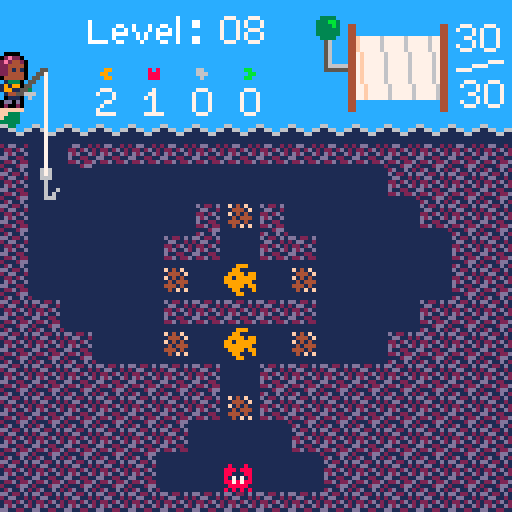
At this point I thought the movement was done and was confident that unlimited unrestricted undo was a smart decision for this game. That’s handy because it was a lot of work!
Version 5: Auto-stopping the reel-in when you drop something (~2 days, November 2018)
There were two things that motivated me to make this change. A few months prior I was able to do some proper playtesting and saw that absolutely no-one understood that pulling a patrol through seaweed would cause you to drop it. I considered ditching the mechanic but was focused on other tasks for the time being. The second was the realization that most of the time after dropping something the next move you want to make is somewhere in the vicinity.
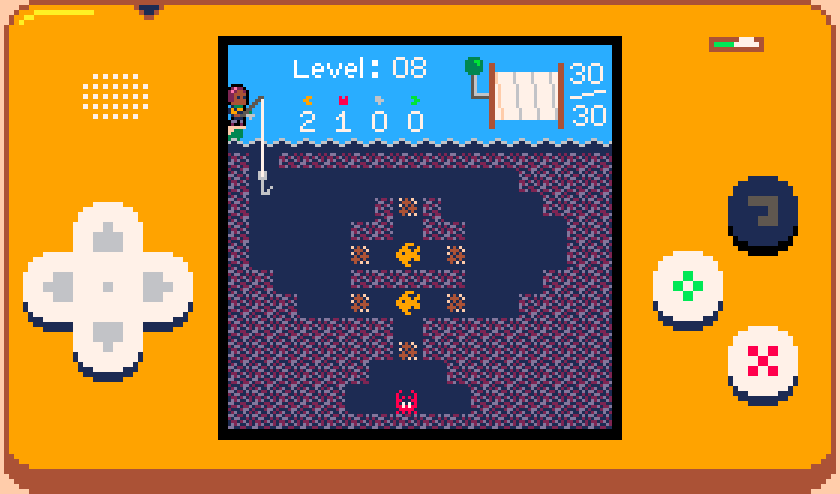
This felt very strange at first; it changes the rhythm of the game and felt like it was interrupting the flow. It successfully highlights the fact that you drop patrols on seaweed, because it stops you and forces you to realise it (dropping something is the only thing that automatically stops the reel). I had to add a locking mechanic to patrols to prevent the one you dropped from moving until the hook comes to rest, because if it isn’t where you left it then it’s unclear what happened. In some cases the hook was left in a position where the route I wanted to take was blocked by the line so I would have to awkwardly press the reel-in button again to backtrack before moving forward. Sound familiar?
Version 6: Backstepping (1 day, January 2019)
Hopefully the final piece of this designer-facing puzzle is to allow the player to backtrack one step at a time. This had been possible for more than a year through the awkward process of pressing the reel-in button then almost immediately pressing a directional button. I’ve made strong, conscious design decisions throughout the project to avoid any kind of real-time requirements for players and hated that a reaction-based mechanic had essentially been introduced. As a player I was doing this because it allowed me to more easily achieve my goals. It was time to add another tool to the toolbelt!
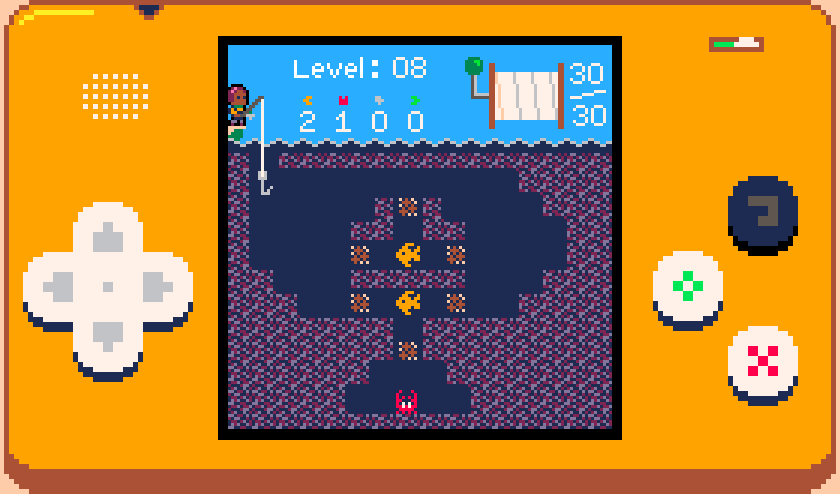
And that is where movement stands today (February 2019). My concerns about this making patrols easier to catch proved true, but I now consider that a good thing. I want all the difficulty to be in working out what what you need to do, not in executing your plans.
Version 7: ???
Judging by this track record I’m due to change something about the movement around October 2019, then January 2020 (No, I don’t plan to still be working on this game in 2020!). I haven’t played enough of the game with the auto-stop and backstepping to be totally confident about them, but they solve a lot of design issues so I reckon it’s just that I’m not used to it yet. Hopefully it feels good to move now and isn’t frustrating! I think the button visuals help with the feel too, especially that d-pad *pats self on back *.
I hope this look at the design evolution for such a seemingly simple mechanic gives some indication of the interesting, sometimes difficult problems I’m encountering along the way. For those who are eager to play, I hope I’ve garnered a little more of your valuable goodwill and patience. Believe me, I want this game to be finished more than anyone.
Curious Fishing
An aquatic puzzle game
| Status | Released |
| Author | RhythmLynx |
| Genre | Puzzle |
| Tags | blocks, chiptune, fantasy-console, Fishing, PICO-8, Pixel Art, Retro, Sokoban, underwater |
| Languages | Arabic, German, English, Spanish; Castilian, French, Italian, Japanese, Korean, Portuguese (Brazil), Russian, Chinese, Chinese (Simplified), Chinese (Traditional) |
| Accessibility | Configurable controls |
More posts
- #15: Why development took so longNov 28, 2022
- #14: Devlog updates and launch statsNov 28, 2022
- #13: Release!Nov 28, 2022
- #12: Localizing a low resolution pixel art gameNov 28, 2022
- #11: OrganizationNov 27, 2022
- #10: Audio techNov 27, 2022
- #09: Interview with sound designer Andrew DoddsNov 27, 2022
- #08: (Work)flow: artNov 27, 2022
- #06: UndoNov 25, 2022

Leave a comment
Log in with itch.io to leave a comment.